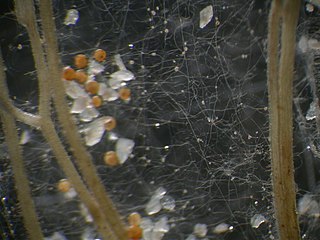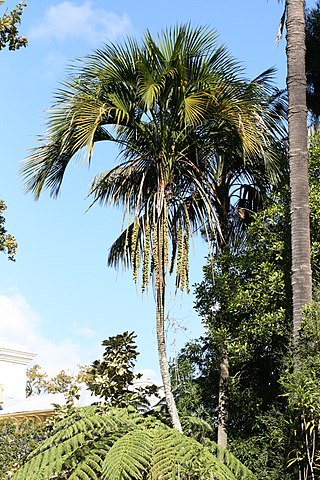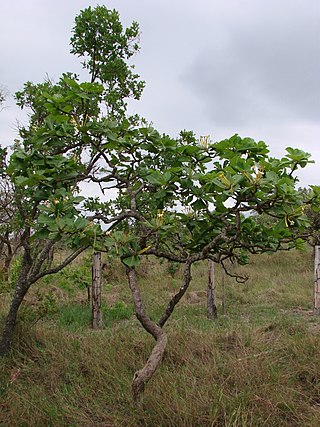
A mycorrhiza is a symbiotic association between a fungus and a plant. The term mycorrhiza refers to the role of the fungus in the plant's rhizosphere, its root system. Mycorrhizae play important roles in plant nutrition, soil biology, and soil chemistry.

An arbuscular mycorrhiza (AM) is a type of mycorrhiza in which the symbiont fungus penetrates the cortical cells of the roots of a vascular plant forming arbuscules. Arbuscular mycorrhiza is a type of endomycorrhiza along with ericoid mycorrhiza and orchid mycorrhiza .They are characterized by the formation of unique tree-like structures, the arbuscules. In addition, globular storage structures called vesicles are often encountered.

Glomeromycota are one of eight currently recognized divisions within the kingdom Fungi, with approximately 230 described species. Members of the Glomeromycota form arbuscular mycorrhizas (AMs) with the thalli of bryophytes and the roots of vascular land plants. Not all species have been shown to form AMs, and one, Geosiphon pyriformis, is known not to do so. Instead, it forms an endocytobiotic association with Nostoc cyanobacteria. The majority of evidence shows that the Glomeromycota are dependent on land plants for carbon and energy, but there is recent circumstantial evidence that some species may be able to lead an independent existence. The arbuscular mycorrhizal species are terrestrial and widely distributed in soils worldwide where they form symbioses with the roots of the majority of plant species (>80%). They can also be found in wetlands, including salt-marshes, and associated with epiphytic plants.

The Diversisporales are an order of generally hypogeous (underground) arbuscular mycorrhizal fungi within the division Glomeromycota. Many have vesicles for energy storage, or auxiliary cells. Species produce a wide range of spore types, hence the name.

Howea belmoreana, the curly palm, kentia palm, or Belmore sentry palm, is a species of flowering plant in the family Arecaceae, endemic to Lord Howe Island, Australia. It and Howea forsteriana probably evolved from a common ancestor through sympatric speciation. The canopy of a mature kentia palm tree spreads 5–10 ft (2–3 m) in diameter and contains roughly 36 leaves.

Tocoyena is a genus of plant in the family Rubiaceae.
Microbial inoculants also known as soil inoculants or bioinoculants are agricultural amendments that use beneficial rhizosphericic or endophytic microbes to promote plant health. Many of the microbes involved form symbiotic relationships with the target crops where both parties benefit (mutualism). While microbial inoculants are applied to improve plant nutrition, they can also be used to promote plant growth by stimulating plant hormone production. Although bacterial and fungal inoculants are common, inoculation with archaea to promote plant growth is being increasingly studied.
The Diversisporaceae are a family of fungi in the order Diversisporales. These fungi form arbuscular mycorrhiza and vesicles in roots.

The Gigasporaceae are a family of fungi in the order Diversisporales. Species in this family are widespread in distribution, and form arbuscular mycorrhiza in roots.
Acaulospora is a genus of fungi in the family Acaulosporaceae. Species in this genus are widespread in distribution, and form arbuscular mycorrhiza and vesicles in roots.
Acaulospora appendicula is a species of fungus in the family Acaulosporaceae. It forms arbuscular mycorrhiza and vesicles in roots. Found in Colombia, the species was described as new to science in 1984.
Acaulospora denticulata is a species of fungus in the family Acaulosporaceae. It forms arbuscular mycorrhiza and vesicles in roots. Isolated from garden soil in Colombia, the fungus was described as new to science in 1987.
Acaulospora morrowiae is a species of fungus in the family Acaulosporaceae. It forms arbuscular mycorrhiza and vesicles in roots. Found in Colombia in soil with native grasses, the species was described as new to science in 1984.
Acaulospora nicolsonii is a species of fungus in the family Acaulosporaceae. It forms arbuscular mycorrhiza and vesicles in roots. It was first described in 1984 in a bulletin of the British Mycological Society.
Darah Serah Bavineh is a village in Darb-e Gonbad Rural District, Darb-e Gonbad District, Kuhdasht County, Lorestan Province, Iran. At the 2006 census, its population was 136, in 29 families.

Soil carbon storage is an important function of terrestrial ecosystems. Soil contains more carbon than plants and the atmosphere combined. Understanding what maintains the soil carbon pool is important to understand the current distribution of carbon on Earth, and how it will respond to environmental change. While much research has been done on how plants, free-living microbial decomposers, and soil minerals affect this pool of carbon, it is recently coming to light that mycorrhizal fungi—symbiotic fungi that associate with roots of almost all living plants—may play an important role in maintaining this pool as well. Measurements of plant carbon allocation to mycorrhizal fungi have been estimated to be 5 to 20% of total plant carbon uptake, and in some ecosystems the biomass of mycorrhizal fungi can be comparable to the biomass of fine roots. Recent research has shown that mycorrhizal fungi hold 50 to 70 percent of the total carbon stored in leaf litter and soil on forested islands in Sweden. Turnover of mycorrhizal biomass into the soil carbon pool is thought to be rapid and has been shown in some ecosystems to be the dominant pathway by which living carbon enters the soil carbon pool.

Rhizophagus irregularis is an arbuscular mycorrhizal fungus used as a soil inoculant in agriculture and horticulture. Rhizophagus irregularis is also commonly used in scientific studies of the effects of arbuscular mycorrhizal fungi on plant and soil improvement. Until 2001, the species was known and widely marketed as Glomus intraradices, but molecular analysis of ribosomal DNA led to the reclassification of all arbuscular fungi from Zygomycota phylum to the Glomeromycota phylum.
Acaulospora rehmii is a species of fungus in the family Acaulosporaceae. It forms arbuscular mycorrhiza and vesicles in roots. Isolated from the soil of a cultivated field in Colombia, the fungus was described as new to science in 1987.

Salix repens, the creeping willow, is a small, shrubby species of willow in the family Salicaceae, growing up to 1.5 metres in height. Found amongst sand dunes and heathlands, it is a polymorphic species, with a wide range of variants. In the UK, at least, these range from small, prostrate, hairless plants at one end of the spectrum to taller, erect or ascending silky-leaved shrubs at the other. This wide variation in form has resulted in numerous synonyms.
Sticta arbuscula is a species of foliose lichen in the family Peltigeraceae. Found in the South American Andes, it was formally described by Bibiana Moncada and Robert Lücking in 2012. The type specimen was collected in Chingaza National Natural Park at an altitude of 3,430 m (11,250 ft). The lichen is found in the Andes of Colombia and Ecuador, at elevations between 3,000 and 3,700 m, where it grows on bark of twigs and stems. It typically associates with bryophytes from the family Lejeuneaceae and the genera Plagiochila, Metzgeria, Jubula, and Omphalanthus. The specific epithet arbuscula refers to the characteristic arbuscular isidia–branched with a stalk at the base.







